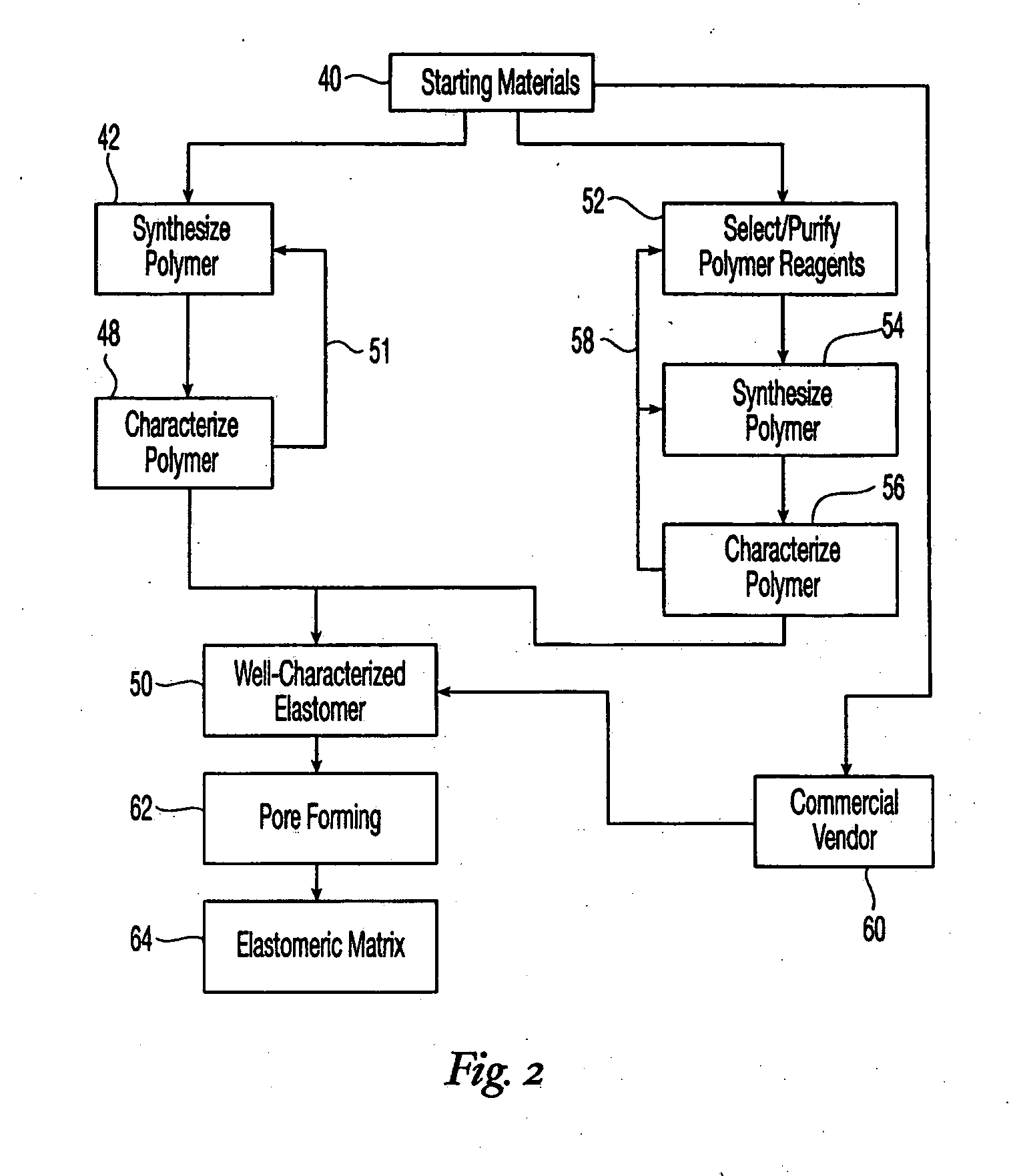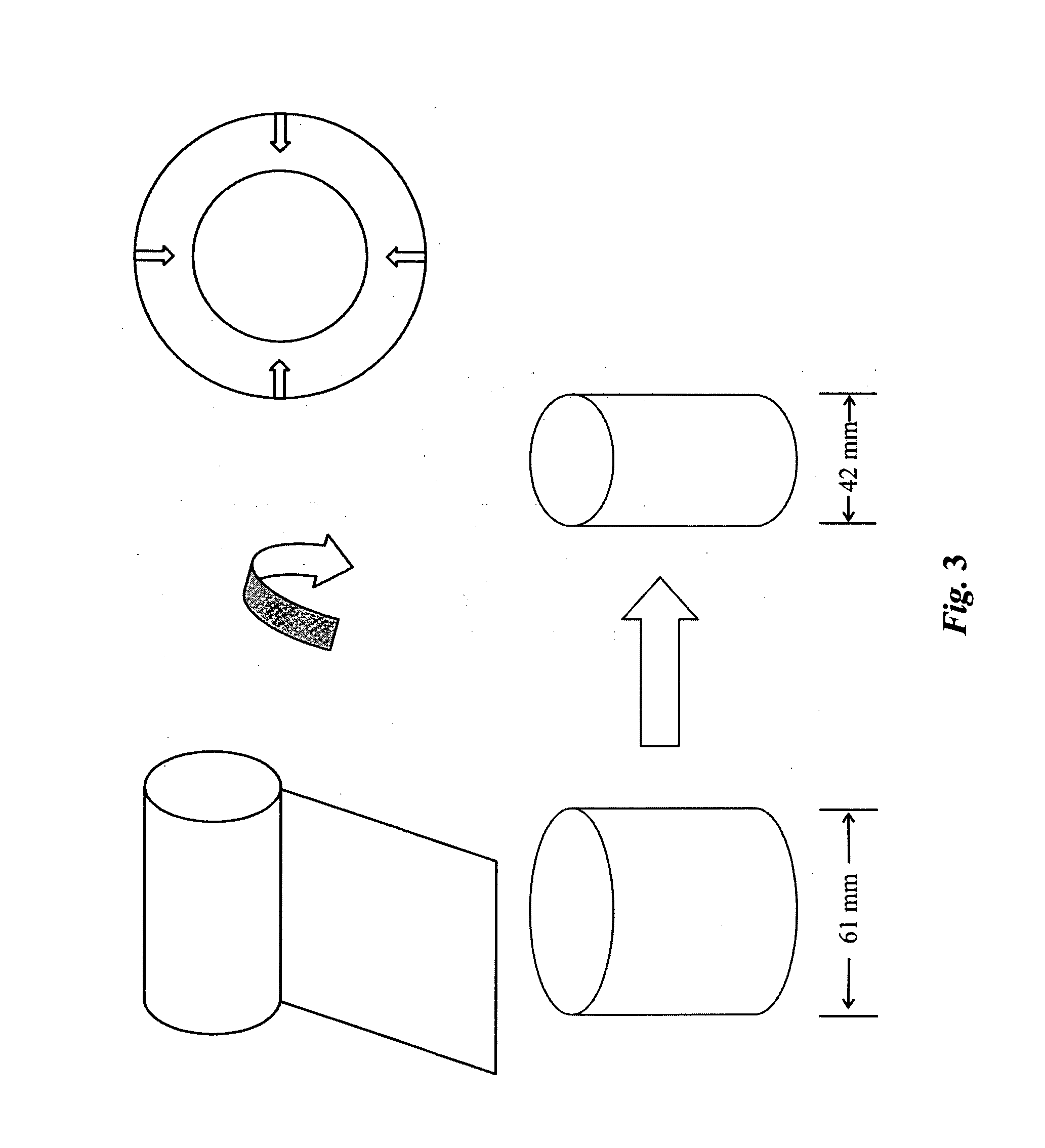High performance reticulated elastomeric matrix preparation, properties, reinforcement, and use in surgical devices, tissue augmentation and/or tissue repair
- Summary
- Abstract
- Description
- Claims
- Application Information
AI Technical Summary
Benefits of technology
Problems solved by technology
Method used
Image
Examples
example 1
Fabrication of Cross-Linked Polyurethane Matrix 1
[0375] The aromatic isocyanate RUBINATE 9258 (from Huntsman) was used as the isocyanate component. RUBINATE 9258 is a liquid at 25° C. RUBINATE 9258 contains 4,4′-MDI and 2,4′-MDI and has an isocyanate functionality of about 2.33. A diol, poly(1,6-hexanecarbonate) diol (POLY-CD CD220 from Arch Chemicals) with a molecular weight of about 2,000 Daltons was used as the polyol component and was a solid at 25° C. Distilled water was used as the blowing agent. The blowing catalyst used was the tertiary amine triethylenediamine (33% in dipropylene glycol; DABCO 33LV from Air Products). A silicone-based surfactant was used (TEGOSTAB BF 2370 from Goldschmidt). A cell-opener was used (ORTEGOL 501 from Goldschmidt). The viscosity modifier propylene carbonate (from Sigma-Aldrich) was present to reduce the viscosity. The proportions of the components that were used is given in Table 2.
TABLE 2IngredientParts by WeightPolyol Component100Viscosity...
example 2
Reticulation of Cross-Linked Polyurethane Matrix 1 and Fabrication of Implantable Devices Therefrom
[0383] Reticulation of the foam described in Example 1 was carried out by the procedure described in Example 6.
[0384] The density of the reticulated foam was determined as described in Example 1. A post-reticulation density value of 2.13 lbs / ft3 (0.034 g / cc) was obtained.
[0385] Tensile tests were conducted on reticulated foam samples as described in Example 1. The average post-reticulation tensile strength parallel to the direction of foam rise was determined as about 31.1 psi (21,870 kg / m2). The post-reticulation elongation to break parallel to the direction of foam rise was determined to be about 92%. The average post-reticulation tensile strength perpendicular to the direction of foam rise was determined as about 22.0 psi (15,480 kg / m2). The post-reticulation elongation to break perpendicular to the direction of foam rise was determined to be about 110%.
[0386] Compressive tests ...
example 3
Fabrication of Collagen-Coated Implantable Devices
[0388] Type I collagen, obtained by extraction from a bovine source, was washed and chopped into fibrils. A 1% by weight collagen aqueous slurry was made by vigorously stirring the collagen and water and adding inorganic acid to a pH of about 3.5. The viscosity of the slurry was about 500 centipoise.
[0389] The mushroom-shaped implantable devices prepared according to Example 2 were completely immersed in the collagen slurry, thereby impregnating each implantable device with the slurry. Thereafter, the collagen-slurry impregnated devices were placed on metal trays which were placed onto a lyophilizer shelf pre-cooled to −45° C. After the slurry in the devices froze, the pressure within the lyophilization chamber was reduced to about 100 millitorr, thereby subliming the water out of the frozen collagen slurry leaving a porous collagen matrix deposited within the pores of the reticulated implantable devices. Thereafter, the temperatur...
PUM
 Login to View More
Login to View More Abstract
Description
Claims
Application Information
 Login to View More
Login to View More - R&D
- Intellectual Property
- Life Sciences
- Materials
- Tech Scout
- Unparalleled Data Quality
- Higher Quality Content
- 60% Fewer Hallucinations
Browse by: Latest US Patents, China's latest patents, Technical Efficacy Thesaurus, Application Domain, Technology Topic, Popular Technical Reports.
© 2025 PatSnap. All rights reserved.Legal|Privacy policy|Modern Slavery Act Transparency Statement|Sitemap|About US| Contact US: help@patsnap.com



